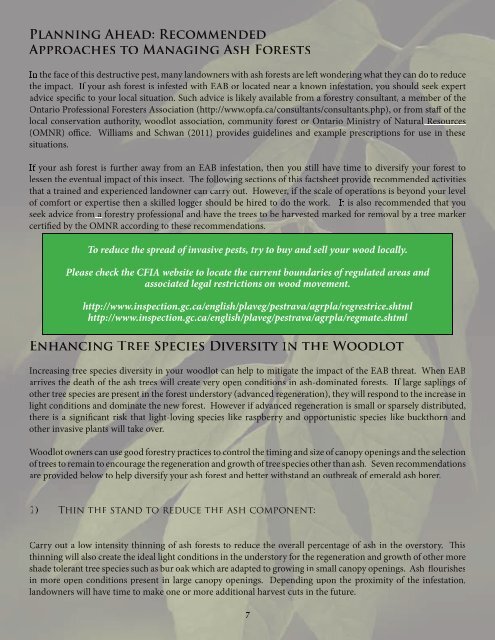Preparing for Emerald Ash Borer: A Landowner's Guide to Managing ...
Preparing for Emerald Ash Borer: A Landowner's Guide to Managing ...
Preparing for Emerald Ash Borer: A Landowner's Guide to Managing ...
- No tags were found...
Create successful ePaper yourself
Turn your PDF publications into a flip-book with our unique Google optimized e-Paper software.
Planning Ahead: RecommendedApproaches <strong>to</strong> <strong>Managing</strong> <strong>Ash</strong> ForestsIn the face of this destructive pest, many landowners with ash <strong>for</strong>ests are left wondering what they can do <strong>to</strong> reducethe impact. If your ash <strong>for</strong>est is infested with EAB or located near a known infestation, you should seekexpertadvice specific <strong>to</strong> your local situation. Such advice is likely available from a <strong>for</strong>estry consultant, a member oftheOntario Professional Foresters Association (http://www.opfa.ca/consultants/consultants.php), or from staff ofthelocal conservation authority, woodlot association, community <strong>for</strong>est or Ontario Ministry of Natural Resources(OMNR) office. Williams and Schwan (2011) provides guidelines and example prescriptions <strong>for</strong> use in thesesituations.If your ash <strong>for</strong>est is further away from an EAB infestation, then you still have time <strong>to</strong> diversify your <strong>for</strong>est <strong>to</strong>lessen the eventual impact of this insect. The following sections of this factsheet provide recommended activitiesthat a trained and experienced landowner can carry out. However, if the scale of operations is beyond your levelof com<strong>for</strong>t or expertise then a skilled logger should be hired <strong>to</strong> do the work. It is also recommended that youseek advice from a <strong>for</strong>estry professional and have the trees <strong>to</strong> be harvested marked <strong>for</strong> removal by a tree markercertified by theOMNR according <strong>to</strong> these recommendations.To reduce the spread of invasive pests, try <strong>to</strong> buy and sell your wood locally.Please check the CFIA website <strong>to</strong> locate the current boundaries of regulated areas andassociated legal restrictions on wood movement.http://www.inspection.gc.ca/english/plaveg/pestrava/agrpla/regrestrice.shtmlhttp://www.inspection.gc.ca/english/plaveg/pestrava/agrpla/regmate.shtmlEnhancing Tree Species Diversity in the WoodlotIncreasing tree species diversity in your woodlot can help <strong>to</strong> mitigate the impact of the EAB threat. When EABarrives the death of the ash trees will create very open conditions in ash-dominated <strong>for</strong>ests. If large saplings ofother tree species are present in the <strong>for</strong>est unders<strong>to</strong>ry (advanced regeneration), they will respond <strong>to</strong> the increase inlight conditions and dominate the new <strong>for</strong>est. However if advanced regeneration is small or sparselydistributed,there is a significant risk that light-loving species like raspberry and opportunistic species like buckthorn andother invasive plants will take over.Woodlot owners can use good <strong>for</strong>estry practices <strong>to</strong> control the timing and size of canopy openings and the selectionof trees <strong>to</strong> remain <strong>to</strong> encourage the regeneration and growth of tree species other than ash. Seven recommendationsare provided below <strong>to</strong> help diversify your ash <strong>for</strong>est and better withstand an outbreak of emerald ash borer.1) Thin the stand <strong>to</strong> reduce the ash component:Carry out a low intensity thinningof ash <strong>for</strong>ests <strong>to</strong> reduce the overall percentage of ash in the overs<strong>to</strong>ry. Thisthinning will also create the ideal light conditions in the unders<strong>to</strong>ry <strong>for</strong> the regeneration and growth of other moreshade <strong>to</strong>lerant tree species such as bur oak which are adapted <strong>to</strong> growing in small canopy openings. <strong>Ash</strong> flourishesin more open conditions present in large canopy openings. Depending upon the proximity of the infestation,landowners will have time <strong>to</strong> make one or more additional harvest cuts in the future.7
















